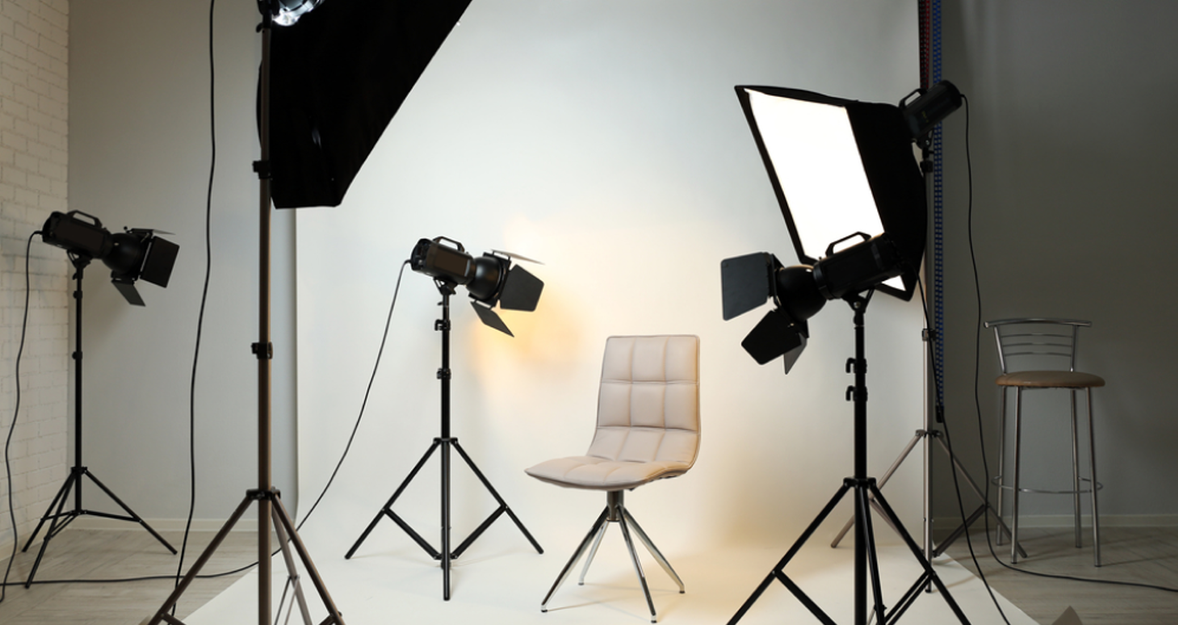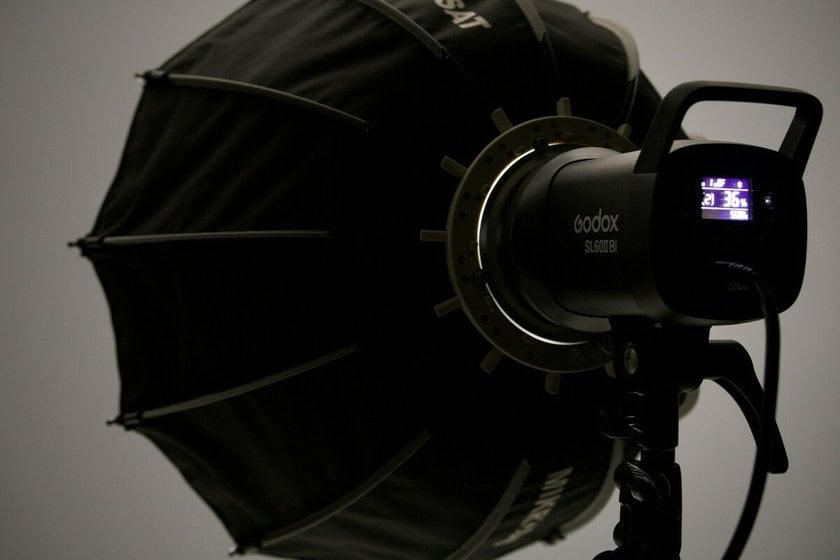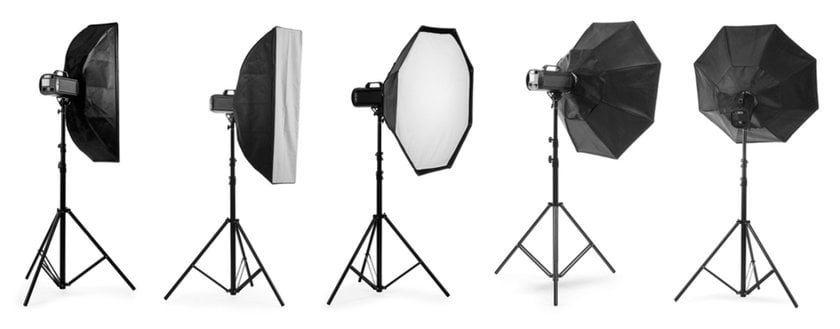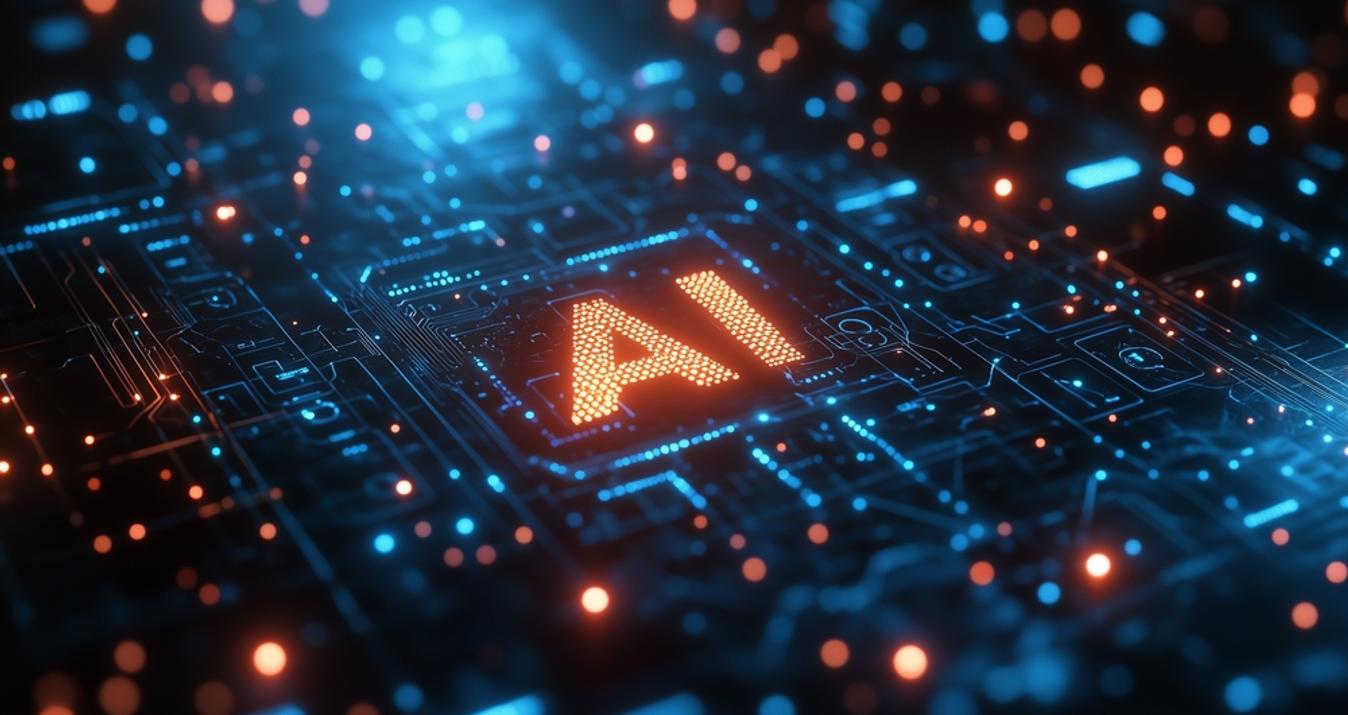Photography Lighting Equipment
Last Updated on July 22, 2025

You don’t need to be a lighting expert—the right photography lighting equipment can transform your shots.
Photography is all about capturing light, and photography lighting is the heartbeat of any great shot. Controlling it can make or break your image, whether you’re snapping portraits, product photos, or candid moments at a wedding. In this article, we’ll discuss the essentials of photography equipment, from light sources to modifiers, and share practical tips to help you shoot your scenes like a pro.
What is Photography Lighting?
 Photography lighting is the deliberate control of light in an image. This could come from natural sunlight, artificial bulbs, or advanced studio rigs. Proper light management plays a huge role in your photos—it controls exposure, color, mood, and even sharpness. When you use the right photography exposure source, you can bring out textures, make your subject stand out from the background, and really shape the overall vibe of your shot.
Photography lighting is the deliberate control of light in an image. This could come from natural sunlight, artificial bulbs, or advanced studio rigs. Proper light management plays a huge role in your photos—it controls exposure, color, mood, and even sharpness. When you use the right photography exposure source, you can bring out textures, make your subject stand out from the background, and really shape the overall vibe of your shot.
Your AI-Powered Photo Editor for MacOS and Windows
Discover Now!Types of Light in Photography
Light comes in different forms, and knowing how to work with each type is crucial for any photographer.
Natural vs. Artificial Light
 Natural is simply sunlight—free, easy to find, and especially great for outdoor shoots or anyone just starting. Its soft, natural quality adds a beautiful, real-life feel to your photos. But it’s not always predictable. The light changes constantly throughout the day, and things like clouds or strong midday sun can throw everything off. It’s gorgeous when it works, but it doesn’t always play nice.
Natural is simply sunlight—free, easy to find, and especially great for outdoor shoots or anyone just starting. Its soft, natural quality adds a beautiful, real-life feel to your photos. But it’s not always predictable. The light changes constantly throughout the day, and things like clouds or strong midday sun can throw everything off. It’s gorgeous when it works, but it doesn’t always play nice.
Artificial light includes studio strobes, LED panels, flashes, and even household lamps. The big win here is control—you always decide the direction, strength, and color. That’s why most illumination equipment for photography falls into this category. Whether shooting portraits indoors or building a full-blown studio, artificial light gives reliable, repeatable results.
Hard Light vs. Soft Light
 Hard illumination creates sharp shadows and high contrast, perfect for dramatic shots or emphasizing textures. Think of bright sunlight on a clear day or a bare bulb. Soft illumination, often achieved with diffusers or softboxes, gently wraps around your subject to produce a flattering, even glow—ideal for portraits or product photography. Understanding these differences helps you pick the right photo shoot sources for your vision.
Hard illumination creates sharp shadows and high contrast, perfect for dramatic shots or emphasizing textures. Think of bright sunlight on a clear day or a bare bulb. Soft illumination, often achieved with diffusers or softboxes, gently wraps around your subject to produce a flattering, even glow—ideal for portraits or product photography. Understanding these differences helps you pick the right photo shoot sources for your vision.
Core Photography Lighting Equipment
Having the right gear makes all the difference in capturing stunning photos. While photography light equipment can get pretty advanced, the essentials are actually easy to obtain.
Photography Light Sources

The foundation of any lighting setup is the light source itself. Common options include:
Continuous lights. These stay on, letting you see exactly how the illumination falls. LEDs and tungsten lights are popular for beginners because they’re easy to use and great for both stills and video.
Strobes. These deliver a powerful burst of brightness, ideal for freezing motion or overpowering ambient light.
Speedlights. Compact and portable, these are great for on-the-go shoots or as a secondary light source.
Each type has strengths, so your choice depends on your shooting style and budget. If you’re looking for software to edit photos to enhance your images after a shoot, tools like Luminar Neo can help polish your visual effects.
Flash and Strobe Lights
 Flash and strobe lights are the backbone of photography illumination equipment. Speedlights are small, attach to your camera’s hot shoe, and are perfect for events or outdoor shoots. Strobes, used in photography studio equipment, are more powerful and are often used in studios for portraits or commercial work. They’re versatile but require some know-how to sync with your camera.
Flash and strobe lights are the backbone of photography illumination equipment. Speedlights are small, attach to your camera’s hot shoe, and are perfect for events or outdoor shoots. Strobes, used in photography studio equipment, are more powerful and are often used in studios for portraits or commercial work. They’re versatile but require some know-how to sync with your camera.
Lighting Functions in Photography
Every light in a setup has a specific job. Here’s a rundown of the key roles photography equipment lighting plays in a shoot.
Key Light
 Your main source of illumination—known as the key light—sets the tone and mood of the scene. It’s typically the strongest light source and is positioned to shape your subject’s features.
Your main source of illumination—known as the key light—sets the tone and mood of the scene. It’s typically the strongest light source and is positioned to shape your subject’s features.
Fill Light
 The fill light softens the shadows that the key lamp creates gently. It’s usually less bright and helps balance the contrast, making the scene more natural. You can use something simple like a reflector or a lower-powered light to lift those darker areas, just enough to brighten them without making them look fake or flat.
The fill light softens the shadows that the key lamp creates gently. It’s usually less bright and helps balance the contrast, making the scene more natural. You can use something simple like a reflector or a lower-powered light to lift those darker areas, just enough to brighten them without making them look fake or flat.
Backlight / Rim Light
 Backlight helps your subject stand out from the background—it adds depth and a nice bit of drama. When you place a light behind your subject, it creates a soft glow or a subtle rim of color around them, which can really make your photos pop. Wondering how to get that look easily? Using a ring light in photography is a great option, especially for portraits—it gives a smooth, even backlight without harsh shadows.
Backlight helps your subject stand out from the background—it adds depth and a nice bit of drama. When you place a light behind your subject, it creates a soft glow or a subtle rim of color around them, which can really make your photos pop. Wondering how to get that look easily? Using a ring light in photography is a great option, especially for portraits—it gives a smooth, even backlight without harsh shadows.
Hair Light
 A hair light adds a gentle glow to your subject’s hair, bringing out texture and helping them pop from the background. Photographers use a simple but powerful trick in portraits and fashion shoots to give photos a polished, professional feel.
A hair light adds a gentle glow to your subject’s hair, bringing out texture and helping them pop from the background. Photographers use a simple but powerful trick in portraits and fashion shoots to give photos a polished, professional feel.
Background Light
 This light brightens the background to create depth or draw attention to a specific backdrop. It’s handy in studio setups because it helps prevent the background from looking flat or dull.
This light brightens the background to create depth or draw attention to a specific backdrop. It’s handy in studio setups because it helps prevent the background from looking flat or dull.
Ambient Light
 Ambient lighting is natural light, like sunlight coming in through a window or the overall light of a room. You can’t eliminate it always, but you can work with it—or blend it with light from a lamp to make it look natural and even. And if your tones are not quite right for the mood you desire, color-correcting your photo after you shoot in post with a photo color corrector will give you just the mood you desire.
Ambient lighting is natural light, like sunlight coming in through a window or the overall light of a room. You can’t eliminate it always, but you can work with it—or blend it with light from a lamp to make it look natural and even. And if your tones are not quite right for the mood you desire, color-correcting your photo after you shoot in post with a photo color corrector will give you just the mood you desire.
Light Modifiers: Shape and Control Your Light
 Modifiers are the unsung heroes of lighting photography equipment. They shape, soften, or direct light to achieve your desired effect. Here’s a table of the most common modifiers and their uses.
Modifiers are the unsung heroes of lighting photography equipment. They shape, soften, or direct light to achieve your desired effect. Here’s a table of the most common modifiers and their uses.
Modifier | Description | Best For |
Softboxes | Diffuse light for a soft, even glow. | Portraits, product photography |
Umbrellas (Shoot-Through and Reflective) | Spread light widely; shoot-through for soft visible radiation, reflective for more control. | General use, budget-friendly setups |
Beauty Dishes | Create a focused, flattering light with soft edges. | Fashion, beauty portraits |
Strip Boxes & Octaboxes | Long, narrow softboxes for dramatic lighting; octaboxes for larger, softer light. | Full-body shots, fashion |
Reflectors (Portable & Collapsible) | Bounce light to fill shadows or redirect light. | Outdoor shoots, budget setups |
Snoots | Narrow the light beam for precise highlights. | Dramatic effects, hair lights |
Grids / Honeycombs | Focus light into a tight beam, reducing spill. | Controlled lighting, accents |
Gobos | Create patterns or shapes with light. | Creative, artistic shoots |
Barn Doors | Control light direction with adjustable flaps. | Studio lighting, precise control |
Color Gels (CTO and Creative Gels) | Add color or correct white balance. | Creative effects, color correction |
Diffusers & Scrims | Soften and spread light for a natural look. | Outdoor or harsh light conditions |
Flags | Block light to control spill or create shadows. | High-contrast, dramatic setups |
Modifiers give you endless creative possibilities. Experimenting with them is one of the best ways to master a photography light setup.
Studio Lighting Equipment & Accessories
Beyond lights and modifiers, photography studio lighting equipment includes accessories that make your setup functional and flexible.
Light Stands & Tripods

Light stands hold gear securely, while tripods keep cameras steady. Both are essential for accurate positioning and safety in the studio.
C-Stands and Boom Arms
 C-stands are incredibly sturdy and perfect for holding lights or modifiers at tough angles. Boom arms come in handy when you need to place gear overhead—great for hair lighting or top-down product shots.
C-stands are incredibly sturdy and perfect for holding lights or modifiers at tough angles. Boom arms come in handy when you need to place gear overhead—great for hair lighting or top-down product shots.
Reflector Holders and Background Supports
 Reflector holders are super handy for keeping your reflectors exactly where you want them. Background supports ensure that your backdrops stay smooth and wrinkle-free. These little helpers are an absolute must-have if you wish to clean, professional-looking studio shots.
Reflector holders are super handy for keeping your reflectors exactly where you want them. Background supports ensure that your backdrops stay smooth and wrinkle-free. These little helpers are an absolute must-have if you wish to clean, professional-looking studio shots.
Backdrops and Mounting Systems
 Paper, fabric, or vinyl backdrops help create the perfect setting for your shot. With the right mounting system, they stay smooth and wrinkle-free, giving your photos a clean, professional finish.
Paper, fabric, or vinyl backdrops help create the perfect setting for your shot. With the right mounting system, they stay smooth and wrinkle-free, giving your photos a clean, professional finish.
Clamps, Rails, and Dolly Systems
 Clamps keep your gear firmly in place, rails help you glide your lights with ease, and dollies bring easy mobility to that moving shot. These enable you to optimize your setup and be more flexible. When shopping for gifts for a photographer, a quality clamp or rail system is always a smart and pragmatic option.
Clamps keep your gear firmly in place, rails help you glide your lights with ease, and dollies bring easy mobility to that moving shot. These enable you to optimize your setup and be more flexible. When shopping for gifts for a photographer, a quality clamp or rail system is always a smart and pragmatic option.
Triggers, Power, and Syncing Devices
 You need reliable syncing tools to fire your lights at the right moment.
You need reliable syncing tools to fire your lights at the right moment.
Wireless Triggers & Remotes
Wireless triggers allow you to fire your lights remotely, allowing you to walk around unrestricted without the hassle of cords. They are just lifesavers, especially when you have complex setups or humongous studios to shoot in.
Sync Cords and PC Sync Cables
These connect your camera to your lights for precise timing. They’re simple but effective, especially for smaller setups.
Slave Mode and Optical Sync
Some flashes in slave mode fire when they detect another burst. Optical sync is great for low-budget systems but sensitive to ambient light.
Infrared and Radio Transmitters
These give you constant communication between your lights and camera, even in bad conditions. Radio transmitters are especially helpful when photographing outdoors.
Modeling Lights
Modeling lamps are low-power continuous sources built into strobes. They let you preview how the illumination will fall before you shoot.
Choosing the Right Lighting Setup for Different Photography Styles
 Different genres demand different photography lighting equipment. Here’s how to tailor your setup.
Different genres demand different photography lighting equipment. Here’s how to tailor your setup.
Portrait Photography
Portraits thrive on soft, flattering light. Use softboxes or beauty dishes as your key light, with a reflector for fill. A hair light adds polish.
Product and Commercial Photography
Product shots need to be clean, and the lights should highlight details. Softboxes and strip boxes work well, with grids to control light spill.
Fashion Photography
Fashion calls for bold, dynamic lighting. Beauty dishes, octaboxes, and backlights create striking looks with high contrast and depth.
Event and Wedding Photography
Portability is key here. Speedlights and reflectors are great for on-the-go illumination, with diffusers to soften harsh venue accents.
Indoor vs. Outdoor Shoots
Indoor shoots give you control with studio lights photography, while outdoor shoots rely on balancing natural light with portable strobes or reflectors. To make images brighter in post-processing, Luminar Neo can enhance outdoor shots.
Tips for Using Photography Light Equipment Effectively
 Here are some practical tips to get the most out of your lighting equipment photography.
Here are some practical tips to get the most out of your lighting equipment photography.
Experiment with lighting ratios. Play with the balance between key and fill lights to control contrast and mood.
Master light positioning. Move the lamps closer or farther to adjust intensity and softness. Small changes make a big difference.
Control light spill with flags and grids. Use these to keep light where you want it and avoid unwanted flares.
Color correction and white balance with gels. Use CTO gels to match artificial light to sunlight or creative gels for artistic effects.
You can also download a helpful Lightroom preset to streamline your editing workflow and maintain brightness consistency.
Photography Lighting Equipment for Beginners
 Getting started with photography gear doesn’t have to be expensive or complicated. It’s totally normal to feel a bit overwhelmed by all the equipment out there. But honestly, you don’t need a fancy studio right from the start. Keep it simple and add to your kit as you go. Whether you’re shooting portraits, products, or content for social media, there are plenty of beginner-friendly tools that’ll help you jump right in.
Getting started with photography gear doesn’t have to be expensive or complicated. It’s totally normal to feel a bit overwhelmed by all the equipment out there. But honestly, you don’t need a fancy studio right from the start. Keep it simple and add to your kit as you go. Whether you’re shooting portraits, products, or content for social media, there are plenty of beginner-friendly tools that’ll help you jump right in.
Budget Studio Lighting Kits
Are you new to studio lights photography? Never mind, you don’t need to spend a fortune. Plenty of starter kits are on the market that contain everything you require: softboxes, stands, and continuous lamps that are easy to use. They’re perfect for small setups or home studios.
Some good starter kits usually include:
Two 85W CFL lights with softboxes
Stands that are lightweight and simple to adjust
A carrying bag to keep all things tidy and mobile
It has enough equipment to handle a simple portrait session or small product shoot without being overwhelming.
Essential Gear for Home Photo Studios
Thinking about setting up a home studio? Here’s the essential gear you’ll want to start with.
Two photo shoot lights or softboxes
A clean backdrop—whether it’s paper, fabric, or a collapsible one
A reflector to bounce light and soften any harsh shadows
A sturdy light stand or tripod
Basic lighting photography equipment, like gels or diffusers, to shape your image
With just these basics, you’ll be ready to create great-quality photos right from your own space. No need to overcomplicate things when you’re just getting started!
Best Lights for Small Spaces
Not everyone has room for a full studio setup. If you work in a tight apartment or small office, look for smaller alternatives.
LED panels (low-heat, dimmable)
Ring lights (ideal for portraits or vlogging)
Clamp lights for easy adjustment
A ring light is especially convenient for small photography setups. It provides soft, complementing illumination with minimal shadows.
Why Choose Luminar Neo for Your Photography Editing
 Even in perfect lighting, every photo can benefit from smart editing. That’s where Luminar Neo comes in. It’s not an editor—a full-fledged creative workspace. Here’s why photographers love it:
Even in perfect lighting, every photo can benefit from smart editing. That’s where Luminar Neo comes in. It’s not an editor—a full-fledged creative workspace. Here’s why photographers love it:
Artificial intelligence-powered solutions speed up editing without sacrificing quality
Easy to operate for beginners and experts alike
Great for quick retouching or batch correction
If you’re looking for a powerful editor, Luminar Neo is a great choice. It can also help you make images brighter, remove imperfections, and even simulate lens blur or depth-of-field effects. You can also enhance your shots with one-click tools like presets or adjust tones with a color changer for pictures. Together, these tools give you full control over your results—even after the shoot.
Exclusive Tools of Endless Possibilities in One AI Editor
Explore Now!FAQ
Can I use photo shoot lights for video as well?
Yes, but make sure they’re continuous lights, like LED panels or fluorescent bulbs. Flash doesn’t work for video because it only fires in short bursts. Some photography equipment is versatile enough to support photo and video shoots. Adjustable color temperature and brightness are especially important for smooth video results.
How do I choose the right modifiers for my shoot?
Start by thinking about the quality of light you want. Want soft, even illumination for a portrait? Go with a softbox. Shooting a dramatic fashion shot? Try a beauty dish or grid. Product photography? Reflectors or strip boxes may help isolate details. There’s no one-size-fits-all solution—choose photography equipment lighting that fits your style, subject, and space.
What’s the difference between flash and continuous light?
Flash (also called strobe) produces a quick burst of bright light, perfect for freezing motion and working with lower ISO settings. Continuous, on the other hand, stays on and lets you see the setting in real-time. Many lighting equipment photography setups include both, depending on the goal. Video shooters typically prefer continuous brightness, while photographers often use flash.
How do studio lights improve photo quality?
Studio lighting gives you control over every element of light intensity, direction, softness, and color. With the right photography studio lighting equipment, you eliminate harsh shadows, particularly of your subject, and achieve sharp, professional-looking images. It also helps to create consistency across your work, especially in commercial or portrait settings.





